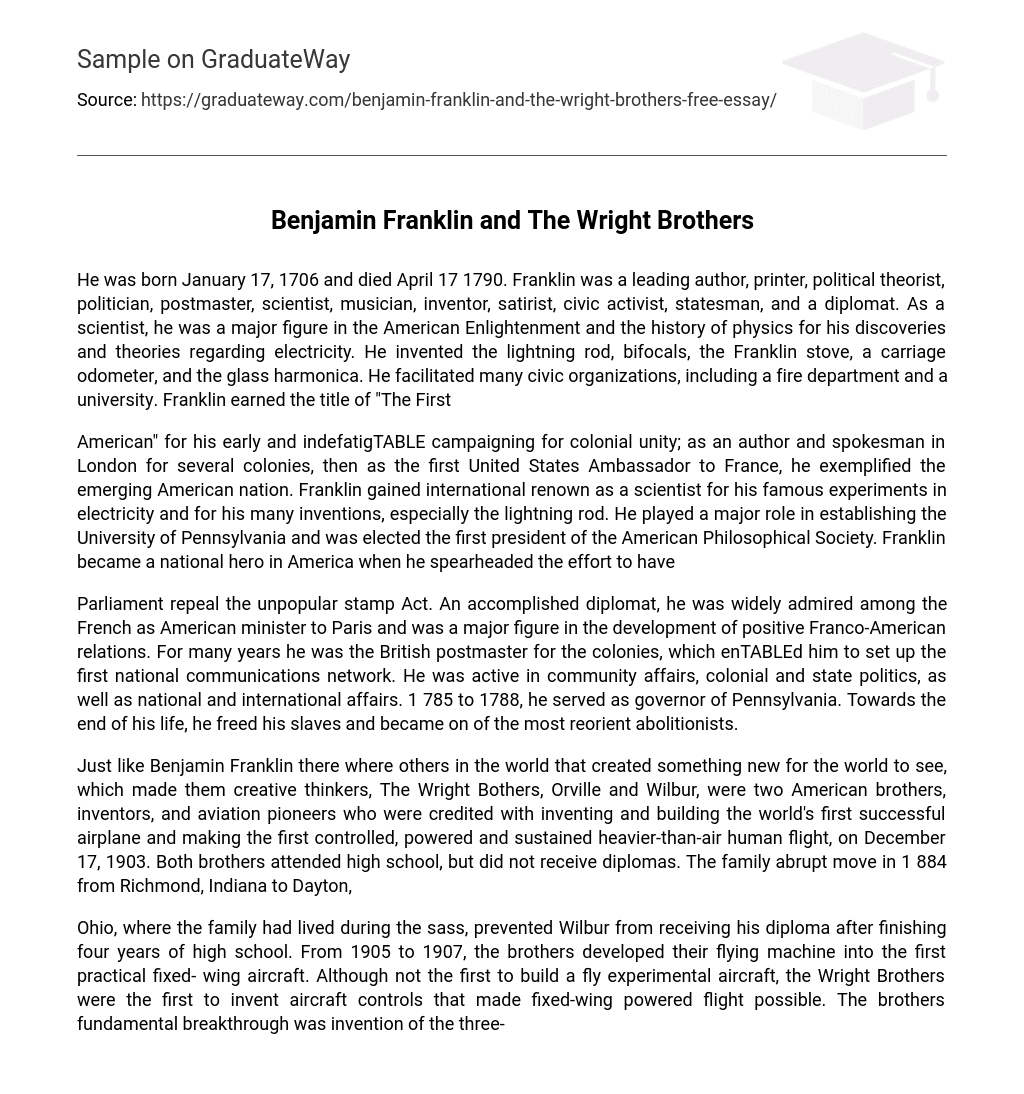Franklin, born on January 17, 1706, and died on April 17, 1790, was a versatile individual who excelled in various fields. He was known as an author, printer, political theorist, politician, postmaster, scientist, musician,
inventor, satirist,
civic activist, statesman,
and diplomat. His contributions to the American Enlightenment and physics made him a prominent scientist. Franklin’s inventions included the lightning rod,
bifocals,
the Franklin stove,
a carriage odometer,
and the glass harmonica. Additionally,
he played instrumental roles in establishing civic organizations such as a fire department
and
a university.
In recognition of his extraordinary accomplishments,
Franklin earned the title of “The First.”Benjamin Franklin, known as the “First American,” worked tirelessly to promote unity among the colonies. He was not only an author and advocate in London for multiple colonies, but also served as the first United States Ambassador to France. Franklin’s efforts in shaping the emerging American nation gained him international recognition as a scientist, especially for his groundbreaking experiments in electricity and various inventions like the lightning rod. Furthermore, he played a crucial part in establishing the University of Pennsylvania and was elected as the first president of the American Philosophical Society. Franklin became highly esteemed in America after leading efforts to secure
Parliament repeals the Stamp Act, an unpopular measure. He is renowned as an accomplished diplomat and garnered widespread admiration among the French people while serving as the American minister to Paris. Additionally, he played a significant role in bolstering Franco-American relations.
Furthermore, he held the position of British postmaster for the colonies for numerous years and established the inaugural national communications network. Moreover, his involvement extended to community affairs, colonial and state politics, as well as national and international matters.
Between 1785 and 1788, he assumed the role of Pennsylvania’s governor. As his life approached its end, he emancipated his slaves and emerged as one of the foremost abolitionists.
Just like Benjamin Franklin, there were others in the world who created something new for the world to see, which made them creative thinkers. The Wright Brothers, Orville and Wilbur, were two American brothers, inventors, and aviation pioneers. They were credited with inventing and building the world’s first successful airplane and making the first controlled, powered and sustained heavier-than-air human flight on December 17, 1903. Both brothers attended high school but did not receive diplomas. The family abruptly moved in 1884 from Richmond, Indiana to Dayton.
Ohio prevented Wilbur from receiving his high school diploma after he finished four years of high school during the sass. From 1905 to 1907, the Wright Brothers enhanced their flying machine, eventually creating the first functional fixed-wing aircraft. While not the pioneers of constructing experimental aircrafts, the Wright Brothers were the first to develop aircraft controls that enabled powered flight with fixed-wings. Their most significant achievement was the invention of three-axis control, which allowed pilots to effectively steer and stabilize the aircraft.
From the outset of their aeronautical undertakings, the Wright Brothers directed their attention towards creating a dependable technique for piloting as the pivotal solution for overcoming “the flying problem.” This distinctive approach deviated significantly from other researchers at that time, who prioritized the development of robust engines. Additionally, by utilizing a homemade wind tunnel, the Wrights gathered more precise data than ever before, thereby facilitating the design and construction of wings and propellers that surpassed all previous iterations in efficiency.
The Wright Brothers’ claim as inventors of the airplane has faced challenges from different groups. There is much controversy regarding the competing claims of early aviators. Despite Aliment’s fate, the brothers supported his approach of practicing gliding to gain control before attempting motor-driven flight. The death of British aeronautic Percy Filcher in a hang gliding accident in 1899 further strengthened their belief that a reliable method of pilot control was crucial for successful and safe flight.
At first, the Wright Brothers considered control to be the unaddressed aspect of “the flying problem”. They believed that enough knowledge regarding wings and engines already existed. This contrasted with more experienced individuals like Adder, Maxim, and Langley who built strong engines, connected them to airframes equipped with untested control devices, and anticipated flying without any prior flight experience.
While the Wrights agreed with Aliment’s idea of practice, they found his method of balance and control, which involved shifting body weight, to be fatally inadequate. They were determined to discover a better approach. Based on observation, Wilbur determined that birds adjusted the angle of their wing ends to roll their bodies right or left. The brothers concluded that this would be a suitable technique for flying machines as well; they could “bank” or “lean” into turns, similar to a bird or a person riding a bicycle, an activity they were very familiar with.
Equally important was their hope that this method would allow for recovery when the wind tilted the machine to one side. They pondered over how to achieve the same effect with man-made wings and eventually stumbled upon wing-warping when Wilbur casually twisted a long inner-tube box at the bicycle shop. The design of their kite and full-sized gliders by the Wrights was based on the work completed in the sass by other aviation pioneers.
The Wright Brothers adopted the basic design of the Chancre Herring biplane hang glider, which flew well in 1896 experiments near Chicago, and used aeronautical data on lift that Alienated had published. In 1903, they built the Wright Flyer I, using their preferred material for construction, spruce, a strong and lightweight wood, and Pride of the West muslin for surface coverings. This made the Wright Brothers famous thinkers due to the time and effort they dedicated to mastering flight controls and shaping the way airplanes fly today.





